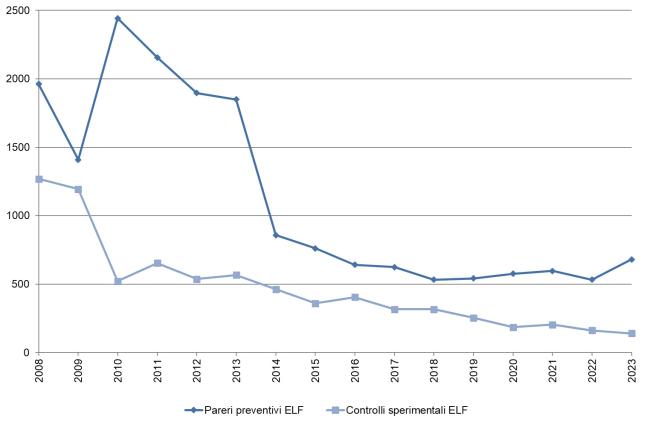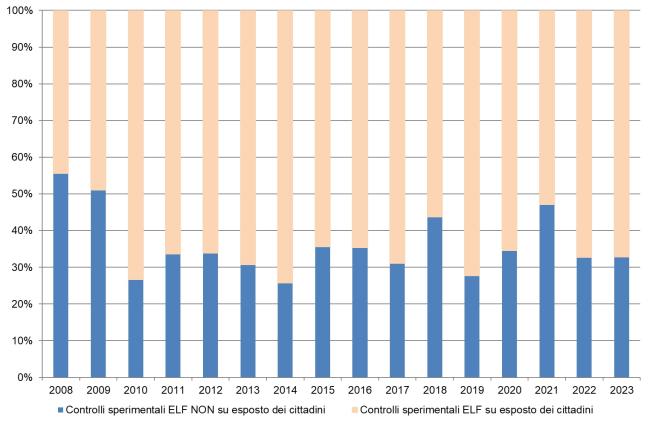Panel 1
Gabriele Bellabarba, Maria Logorelli
The indicator describes the activities carried out by regional environmental protection agencies (ARPA)/ provincial environmental protection agencises (APPA)in terms of preliminary opinions and experimental inspections conducted through field measurements on Exstremely Low Frequencies (ELF) sources.
Analyzing the period from 2008 to 2023, both preliminary opinions and experimental inspections show a rather variable trend over time but are generally characterized by a decline. Specifically, from 2008 to 2023, they decreased by 65.3% (from 1,961 to 681) and 89% (from 1,269 to 140), respectively.
Requests for inspections from citizens through formal complaints have been decreasing, suggesting a reduction in social concern regarding this type of electromagnetic source, which in the past had raised significant worries. However, public attention to exposure to electric and magnetic fields generated by power lines remains high. In fact, in 2023, citizen-requested inspections accounted for 65% of the total inspections conducted (91 out of 140).
The indicator describes the activities carried out by ARPA/APPA in terms of preliminary opinions and experimental inspections conducted through field measurements on Extremely Low Frequencies (ELF) sources. It also provides information on the number of monitoring campaigns conducted by ARPA/APPA near ELF installations and the magnetic field induction levels in the environment as recorded through continuous measurements.
Quantify the response to regulatory requirements regarding control and monitoring activities for ELF installations (power lines and transformer stations).
Framework Law 36/2001 and DPCM 07/08/2003 (ELF); DD 29/05/2008
Panel 2
The Italian Institute for Environmental Protection and Research, different years, Environmental Data Yearbooks
The Italian Institute for Environmental Protection and Research, Thematic Reports
The information related to the monitoring activities carried out by ARPA/APPA is affected by certain challenges, primarily linked to the availability of well-established local data collection tools (databases, registers) and the limited internal human resources within ARPA/APPA dedicated to this metadata collection activity.
Synergistic actions by the stakeholders involved in supporting the flow of information through appropriate regulatory tools and targeted activities aimed at analyzing the aforementioned challenges, with the goal of clarifying issues and proposing solutions to ensure greater uniformity and completeness of data at the national level.
Data quality assessment
Electromagnetic Fields Observatory
15/20
2008-2023
Indicator assessment
Calculation of the total number of experimental inspections for ELF installations across the national territory. Calculation of the total number of preliminary opinions for ELF installations across the national territory. The calculation includes the regions that have provided updated and complete data.
Considering the complete data provided by ARPA/APPA representatives for 2023 (Piedmont, Aosta Valley, Lombardia, Autonomous Province of Trento, Friuli-Venezia Giulia, Liguria, Emilia-Romagna, Tuscany, Umbria, Lazio, Abruzzo, Molise, Campania, Apulia, and Sicily), it is observed that the number of experimental inspections conducted on power lines (137) accounts for 76.1% of the total inspections carried out on ELF sources (180) (Table 1).
Electrical substations, although to a lesser extent than power lines, continue to be subject to monitoring by the agencies due to the challenges arising from their specific location—such as secondary transformer substations often situated within residential buildings.
It is also evident that the public is sensitive to the presence of both types of ELF sources. In 2023, 88 inspections on power lines were requested by citizens, compared to 33 for electrical substations. Citizen-requested inspections on substations and power lines represent 67.2% of the total experimental inspections (121 out of 180) (Table 1).
Analyzing the period from 2008 to 2023, a decrease in preventive opinions was recorded in 2009, amounting to -28.1% (from 1,961 to 1,409). However, in 2010, compared to the previous year, there was a sharp increase (+73.4%) (from 1,409 to 2,443). From 2011 to 2018, a gradual decline continued, reaching a value of 527 in 2018 (-75.6% compared to 2011). In 2019, an increase was observed, which, except for 2022 when a decline was recorded (-8.9%), continued until 2023 (+25.9%) (rising from 541 to 681).
Regarding the experimental inspections carried out, the trend over time has been quite variable but characterized by an overall decline. In fact, from 2008 to 2023, they decreased by 89% (from 1,269 to 140).
As shown in Figure 2, ELF inspections carried out by ARPA/APPA in response to citizen complaints compared to the total inspections conducted exhibit a rather fluctuating trend: in 2008, the minimum value was recorded (44.4%) (564 out of 1,269), while in 2014, the maximum was observed (74.2%) (343 out of 462). In 2023, compared to 2022, there was a decrease of 2.3 percentage points.
Both the regions that provided complete data for the examined period (2008-2023) and those for which missing information could be integrated using data from the previous year or, if unavailable, from the first available subsequent year were considered. These regions include Piedmont, Aosta Valley, Lombardia, Trentino-Alto Adige, Veneto, Friuli-Venezia Giulia, Liguria, Emilia-Romagna, Tuscany, Umbria, Marche, Abruzzo, Puglia, and Basilicata.
Data
Table 1: Opinions and Inspections for ELF Installations in Italy (2023)
ISPRA elaboration based on ARPA/APPA data (EMF Observatory)
a Region/Autonomous Province that provided complete and updated data and was therefore included in the calculation of the national total;
b Data not updated by the regional contact;
c Data provided does not cover the entire regional territory;
nd: data not available.
Table 2: Number of monitoring campaigns conducted in the presence of ELF installations in 2023
ISPRA elaboration based on ARPA/APPA data (EMF Observatory)
a Data not updated by the regional contact;
b Data provided does not cover the entire regional territory;
nd: data not available.
Table 3: Percentages of monitoring campaigns conducted in 2023 on both power lines and electrical substations with magnetic field induction values within the four intervals: 1 microtesla, 1-3 microtesla, 3-10 microtesla, ≥ 10 microtesla
ISPRA elaboration based on ARPA/APPA data (EMF Observatory)
a Data not updated by the regional contact; b Data provided does not cover the entire regional territory; * The data related to measurements is cumulative for power lines and substations; nd: data not available.
Figure 1: Number of preventive opinions and control interventions on ELF field sources
ISPRA elaboration based on ARPA/APPA data (EMF Observatory)
For the aforementioned trend, the regions/autonomous provinces that provided complete data for the 2008-2023 period for ELF sources were considered, as well as those for which missing information was supplemented by carrying over relevant data from the previous year or, in the absence of such data, from the first available subsequent year.
Figure 2: Percentage of experimental checks conducted on citizen complaints versus those not based on citizen complaints for ELF installations
ISPRA elaboration based on ARPA/APPA data (EMF Observatory)
For the aforementioned trend, the regions/autonomous provinces that provided complete data for the 2008-2023 period for ELF sources were considered, as well as those for which missing information was integrated by including relevant data from the previous year or, in the absence of such data, from the first available subsequent year.


The control activity on ELF installations carried out by ARPA/APPA across the territory tends to decrease, reflecting the overall decline in preventive opinions issued by the agencies. However, this reduction still allows them to meet individual citizen requests for inspections. Public concern remains high regarding exposure to electric and magnetic fields generated by power lines.
It is important to emphasize that, given the stable length of power lines, it is natural for monitoring activities not to increase but rather to ensure oversight of key critical situations in the territory.
To assess the levels of magnetic field induction present in the environment near ELF installations, the results of monitoring campaigns conducted in 2023 as part of ARPA/APPA's control activities were collected at the regional level. These results are expressed as the percentage of monitoring campaigns carried out in 2023 on both power lines and electrical substations, categorized into four magnetic induction field ranges: <1 microtesla, 1-3 microtesla, 3-10 microtesla, and ≥10 microtesla.
Table 3 shows that for the regions/autonomous provinces that provided complete and updated data for 2023 (Piedmont, Aosta Valley, Lombardyia, Autonomous Province of Trento, Friuli-Venezia Giulia, Liguria, Emilia-Romagna, Tuscany, Umbria, Lazio, Abruzzo, Molise, Puglia, and Sicily), no non-compliance cases were found concerning the 10-microtesla attention threshold, except for one instance. However, significant percentages were recorded below 3 microtesla, which represents the quality objective set by current regulations.
It is evident that in regions where a greater number of monitoring campaigns were conducted, the information regarding the levels of electric and magnetic fields in the environment is more representative of the actual territorial conditions.